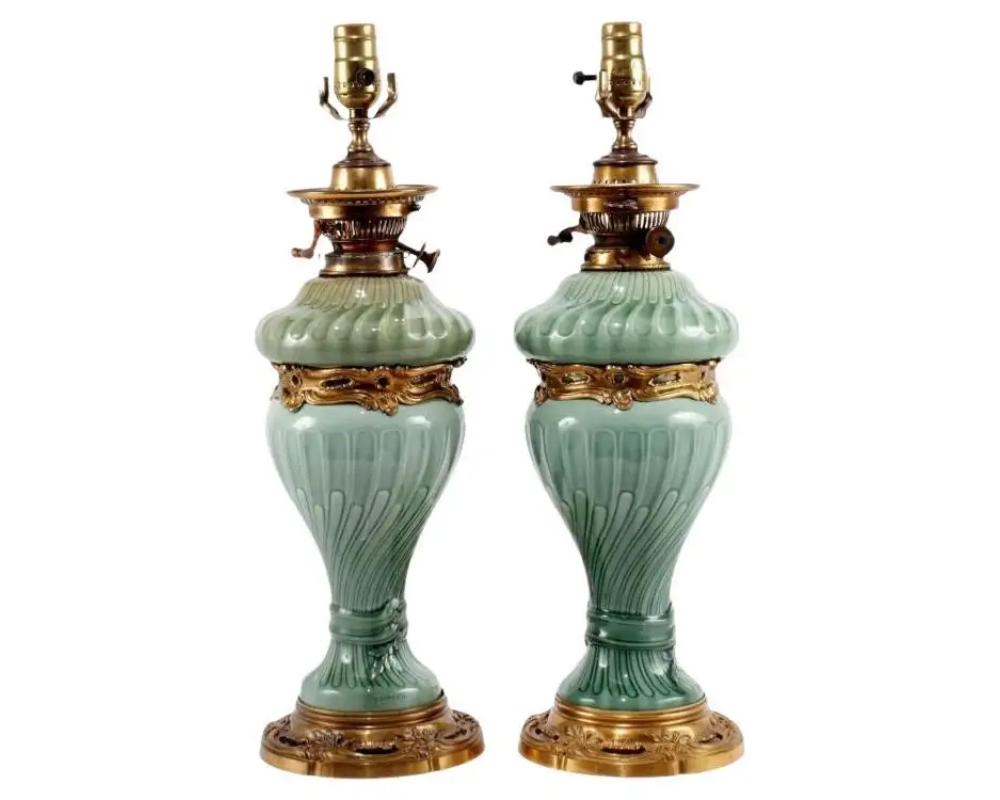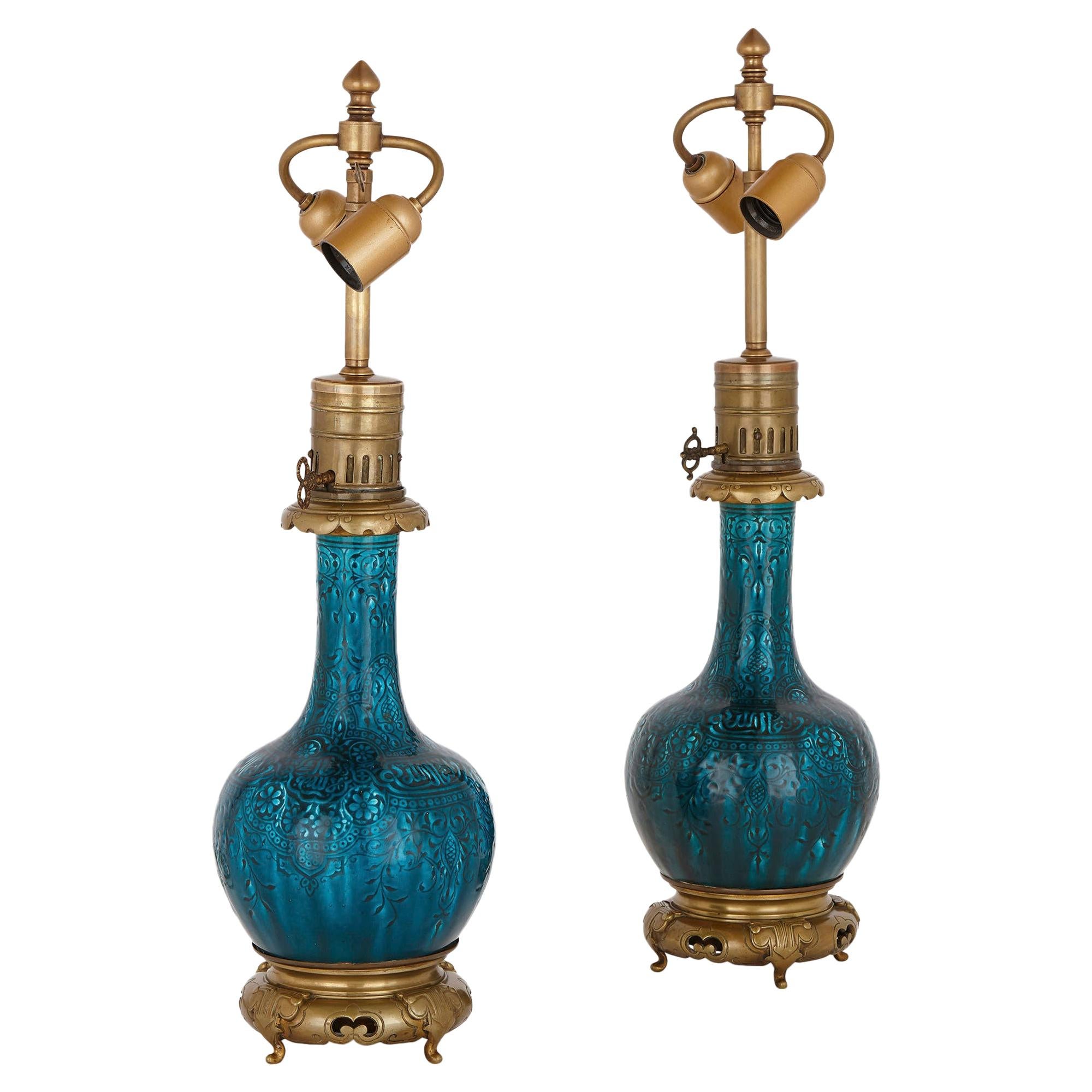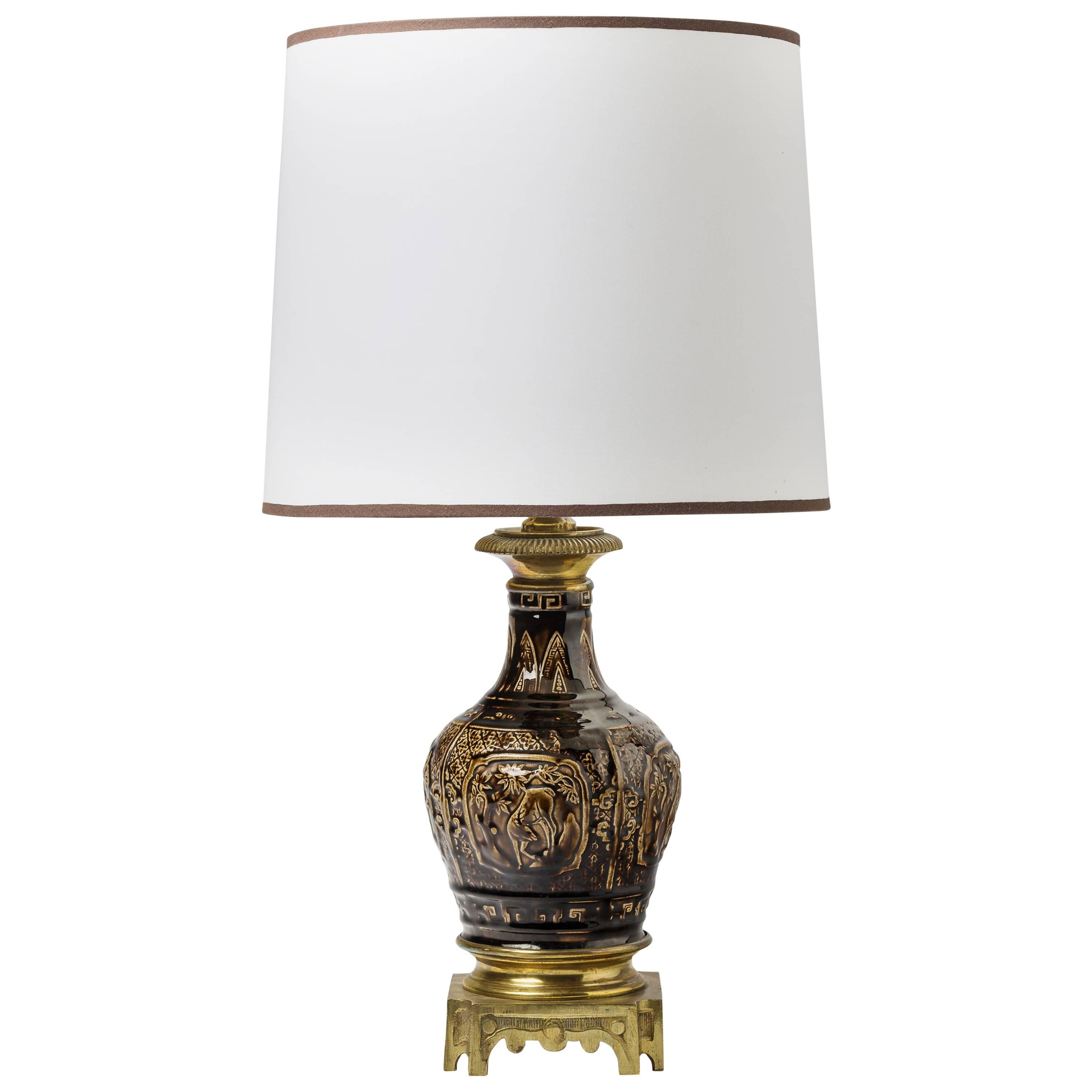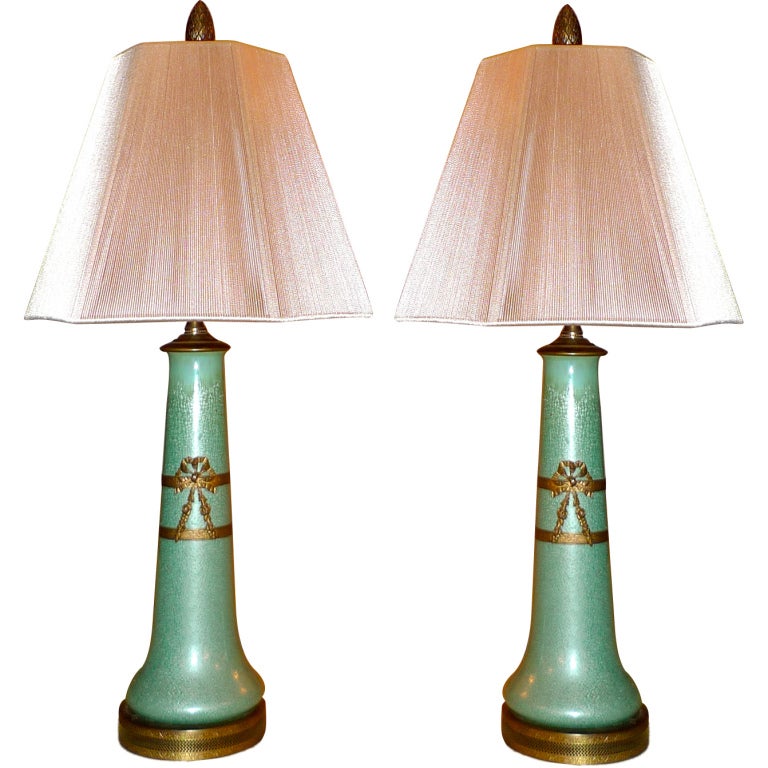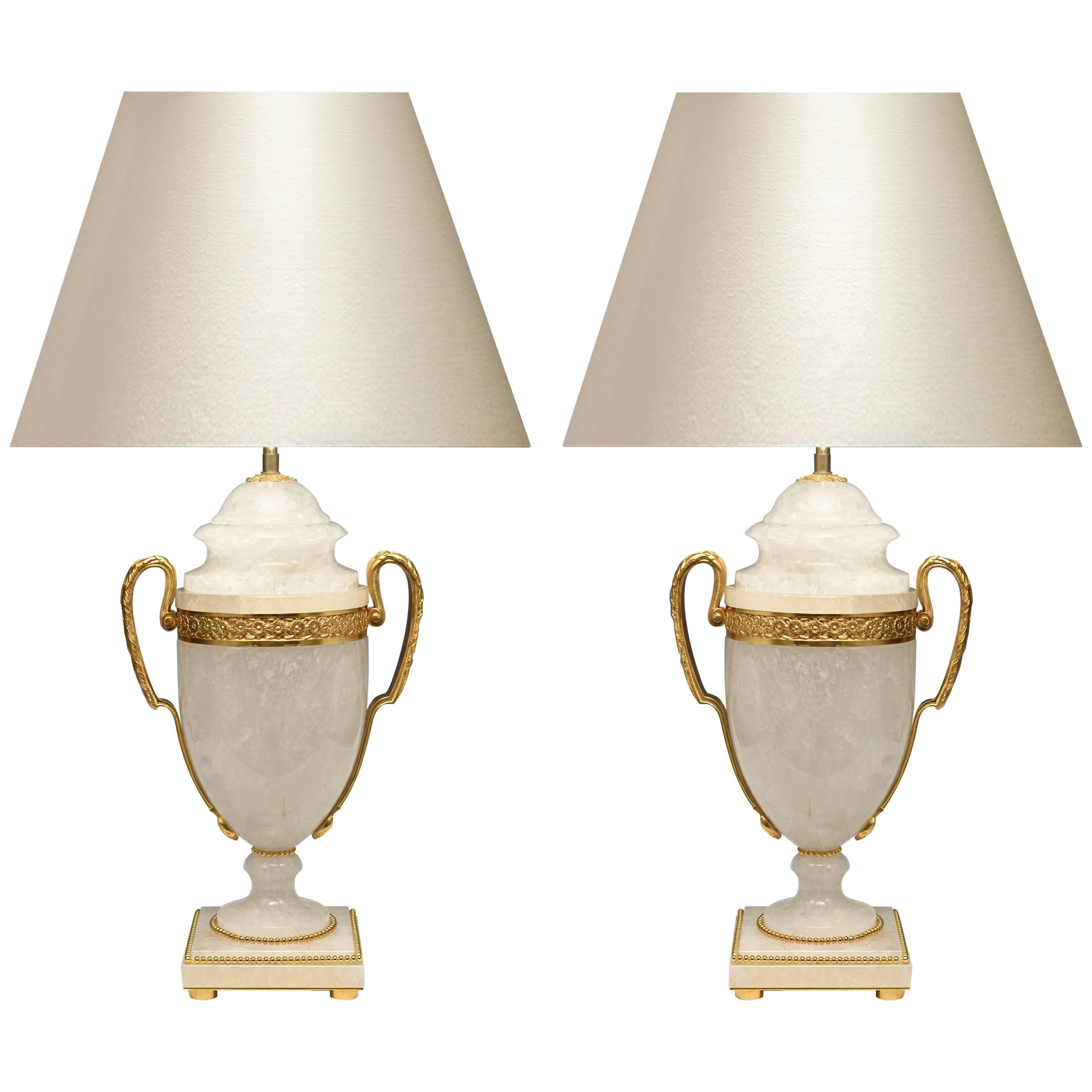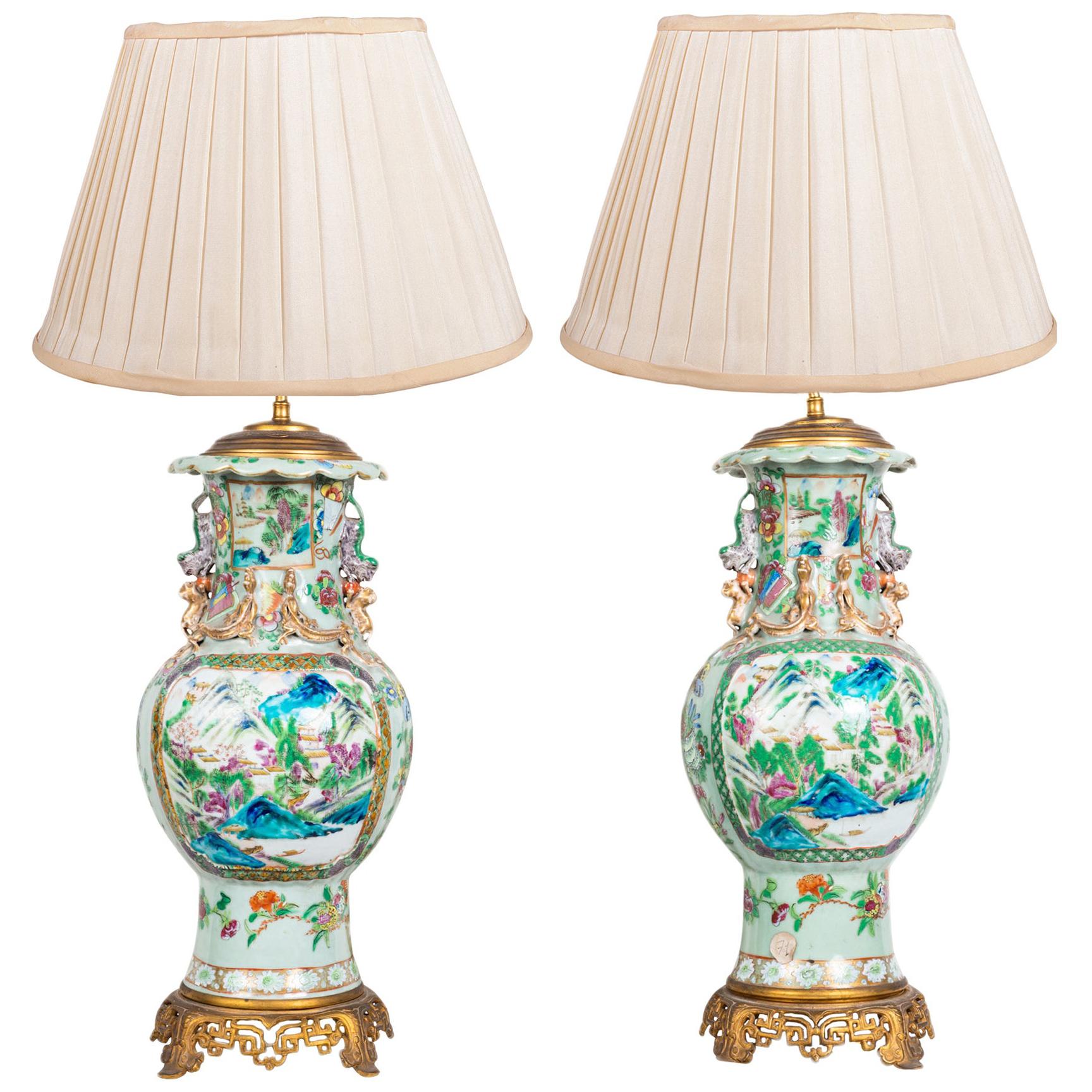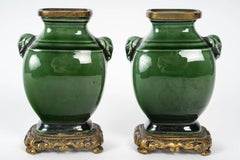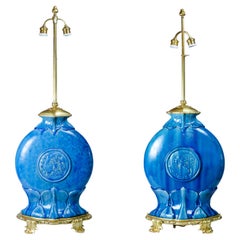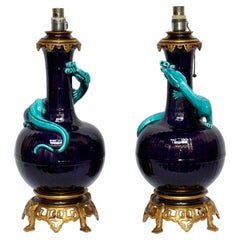
Pair of Théodore Deck Lizards Vases Ormolu-Mounted in Lamps
View Similar Items
Want more images or videos?
Request additional images or videos from the seller
1 of 16
Pair of Théodore Deck Lizards Vases Ormolu-Mounted in Lamps
About the Item
- Creator:Theodore Deck (Maker)
- Dimensions:Height: 21.66 in (55 cm)Width: 8.67 in (22 cm)Depth: 8.67 in (22 cm)
- Sold As:Set of 2
- Style:Chinoiserie (In the Style Of)
- Materials and Techniques:
- Place of Origin:
- Period:
- Date of Manufacture:circa 1875
- Condition:Wear consistent with age and use.
- Seller Location:Saint-Ouen, FR
- Reference Number:1stDibs: LU2612324735262
About the Seller
4.9
Vetted Seller
These experienced sellers undergo a comprehensive evaluation by our team of in-house experts.
1stDibs seller since 2017
56 sales on 1stDibs
Typical response time: 1 hour
More From This SellerView All
- Théodore Deck (1823-1891), Miniature Pair of Faience Vases circa 1870By Theodore DeckLocated in Saint-Ouen, FRTheodore Deck (1823-1891) A deep green enameled faience miniature pair of vases molded in the Chinese Archaistic Taste. Coves in the shape of elepha...Category
Antique 1870s French Chinoiserie Vases
MaterialsFaience
- Pair of Porcelain Vases Ormolu-Mounted in Lamps by Gagneau Paris XIXth CenturyBy Gagneau ParisLocated in Saint-Ouen, FRPair of large Japanese Porcelain Cone Shape Vases with Imari decoration Important mounts in ormolu and gilded metal, the base decorated with a laurel wreath, the upper part of falling leaves and a frieze of knotted ribbon. The mounts signed Gagneau, 115 R. Lafayette. Circa 1860 With their original aluminium bulb cover and original gilding Vase it self Height 47 cm The Gagneau Company is one of the most famous lighting factories in Paris in the nine-teenth century, established in 1800 at 25 rue d'Enghien in Paris and later at 115 rue de Lafayette. She has participated in many exhibitions throughout this century. She began in 1819 with the Exposition des Produits de l'Industrie and later participated in the Universal Exhibitions where she was part of the jury in the category of art bronzes (class 25) at the Universal Exhibition in Paris in 1889. "Imari" was simply the trans-shipment port for Arita wares, from where they went to the for-eign trading outposts at Nagasaki. It was the kilns at Arita which formed the heart of the Japanese porcelain industry. Arita's kilns were set up in the 17th century, after kaolin was discovered in 1616. A popular legend attributes the discovery to an immigrant Korean potter, Yi Sam-Pyeong (1579–1655), although most historians consider this doubtful. After the discovery, some kilns began to produce revised Korean-style blue and white porcelains, known as Early Imari, or "Shoki-Imari". In the mid-17th century, there were also many Chinese refugees in northern Kyushu due to the turmoil in China, and it is said that one of them brought the overglaze enamel coloring technique to Arita. Thus Shoki-Imari developed into Ko-Kutani, Imari, and later Kakiemon, which are sometimes taken as a wider group of Imari wares. Ko-Kutani was produced around 1650 for both export and domestic market.Kutani Ware is characterized by vivid green, blue, purple, yellow and red colors in bold designs of landscapes and nature. Blue and white porcelain pieces continued to be produced and they are called Ai-Kutani. Ko-Kutani Imari for the export market usually adopted Chinese design structure such as kraak style, whereas Ai-Kutani for the domestic market were highly unique in design and are ac-cordingly valued very much among collectors. Ko-Kutani style evolved into Kakiemon-style Imari, which was produced for about 50 years around 1700. Kakiemon was characterized by crisp lines, and bright blue, red and green designs of dramatically stylized floral and bird scenes. Imari achieved its technical and aes-thetic peak in the Kakiemon style, and it dominated the European market. Blue and white Kakiemon is called Ai-Kakiemon. The Kakiemon style transformed into Kinrande in the 18th century, using underglaze blue and overglaze red and gold enamels, and later additional colors. Imari began to be exported to Europe when the Chinese kilns at Jingdezhen were damaged in the political chaos and the new Qing dynasty government halted trade in 1656–1684. Ex-ports to Europe were made through the Dutch East India Company, and in Europe the des-ignation "Imari porcelain" connotes Arita wares of mostly Kinrande Imari. Export of Imari to Europe stopped in mid-18th century when China resumed export to Eu-rope, since Imari was not able to compete against Chinese products due to high labor costs. By that time, however, both Imari and Kakiemon styles were already so popular among Eu-ropeans that the Chinese export porcelain copied both, a type known as Chinese Imari. At the same time, European kilns, such as Meissen and English potteries such as Johnson Bros. and (Royal) Crown Derby, also imitated the Imari and Kakiemon styles. Export of Imari surged again in late 19th century (Meiji era) when Japonism flourished in Europe.Thus, in the western world today, two kinds of true Japanese Imari can...Category
Antique 1880s French Japonisme Table Lamps
MaterialsBronze
$8,408 Sale Price / set30% Off - Theodore Deck '1823-1891', a Japonisme Polychromed Faience Quadrangular VaseBy Theodore DeckLocated in Saint-Ouen, FRTheodore Deck (1823-1891) A Polychromed Faience quadrangular vase, decorated in a cartouche with butterfly and birds on branches of prunus and peonies in the Japanese Taste on a pu...Category
Antique Late 19th Century French Japonisme Vases
MaterialsFaience
- A Théodore Deck (1823-1891) Enamelled Faience Soliflore Vase circa 1875By Theodore DeckLocated in Saint-Ouen, FRThéodore DECK (1823-1891) A polychromatic enamelled earthenware soliflore and quadrangular shape vase with Sino-Japanese inspiration design of flowers and geometrical friezes all around. Impressed uppercase mark "TH.DECK" under the base. Circa 1875 Born in Guebwiller in Alsace, Théodore Deck trained as a ceramist in his home region, then in Germany. He went into partnership with his brother, Xavier Deck, to create his own factory in Paris in 1858. At the Exhibition of Industrial Arts in 1864, he presented pieces covered with transparent enamels that were not cracked, and then made his first attempts at reliefs under transparent enamels. He developed a bright turquoise color, famously renowned as "Bleu Deck". It is this nuance that we find on the salamander represented on this vase. In 1887 he published a treatise entitled "La Faïence", in which he explained some of his discoveries. That same year, he became director of the Manufacture de Sèvres. Theodore Deck (1823-1891) is a French ceramist born in Guebwiller in Alsace. He is passionate about chemistry and the physical sciences. In 1841, he joined the master stove maker Hügelin father as an apprentice in Strasbourg. In two years, he learned of the methods inherited from the 16th century, such as the encrustation of colored pastes in the style of Saint-Porchaire. This apprenticeship did not prevent him from spending his free time draw-ing or modeling clay in the studio of sculptor André Friederich. Escaping military service, he made a tour of Germany as is the tradition with fellow Alsatian stove-makers. The quality of his work allows him to obtain important orders in Austria for the castles of the provinces and the imperial palaces, in particular for the palace of Schönbrunn. He continues his journey in Hungary to Pest, to Prague, then, going north through Dresden, Leipzig, Berlin and Hamburg. On the strength of his apprenticeship, he arrived in Paris in 1847. Recommended by Hügelin, he went to the stove factory of the Bavarian potter Vogt, located rue de la Roquette. The Revolution of 1848 interrupts production and Deck decides to return to his hometown. His family then advised him to set up a small terracotta workshop: he made a few busts, statuettes, vases, lamps and copies of famous antiques there. Aware that this situation would not allow him to provide for himself properly, he returned to Paris in 1851 where he was employed by the widow Dumas, daughter of the earthenware maker Vogt for whom he had worked. Hired as a foreman, he supplied the drawings and models to the workers, while working the land himself. The following year, he made the decision to settle not far from his former employer at 20, rue de la Fontaine-au-Roi, probably using his ovens. His brother, Xavier Deck, joins him. It was officially in 1858 that the Deck brothers created their business and settled in Paris at 46, boulevard Saint-Jacques. Initially, the brothers only carry out coatings for stoves. But the business is going so well that barely a year after their installation, they want to diversify their production and engage in ceramics for the cladding of buildings as well as in shaped parts. Deck is interested in politics. In 1870, he opted for French nationality and was elect-ed deputy mayor in the 15th arrondissement of Paris. In 1861, at the Salon des arts et industries de Paris, which was held on the Champs-Élysées, Théodore Deck exhibited his works for the first time: these were pieces with an inlay decoration called “Henri II” and others. pieces covered with turquoise blue enamel or decoration in the style of Iznik ceramics.If he wins a silver medal, reviews are mixed, however. The following year, on the occasion of the Universal Exhibition of 1862 in London, he won over English customers. He surprised by presenting, like the previous year, his Alhambra Vase...Category
Antique 1870s French Japonisme Vases
MaterialsFaience
$4,739 Sale Price30% Off - Théodore Deck (1823-1891) Faience Paneled Fourteen-Tile Rectangular Wall PlaquBy Theodore DeckLocated in Saint-Ouen, FRA Théodore Deck (1823-1891) Faience Paneled Fourteen-Tile Rectangular Wall Plaque Polychromic Earthenware very finely hand-painted, designed with a couple of pheasants among vegetat...Category
Antique 1870s French Japonisme Decorative Art
MaterialsFaience, Wood
- Émile GALLE (1846-1904) "Paysage Vosgien" Glass Lamp circa 1900By Emile GalléLocated in Saint-Ouen, FRÉmile GALLE (1846-1904) "Paysage Vosgien" A multilayer glass lamp by Gallé With an etched decor of a green and blue Vosgien landscape on the foot and of flying eagles on the lamps...Category
Antique Early 1900s French Art Nouveau Table Lamps
MaterialsBronze
You May Also Like
- Pair of French Theodore Deck Ormolu-Mounted Celadon Porcelain LampsBy Theodore DeckLocated in New York, NYA Pair of French Theodore Deck ( 1823-1891) Ormolu-Mounted Celadon Porcelain Lamps, circa 1870. A very elegant pair of celadon green porcelain lamps in the Chinese taste, mounted ...Category
Antique 19th Century French Table Lamps
MaterialsOrmolu
- Pair of "Blue Glaze" Lamps Made by Theodore DeckBy Theodore DeckLocated in Ciudad Autónoma Buenos Aires, CPair of Blue Glaze ceramic table lamps, with bronze base and stem, made by Theodore Deck (1823-1891). Signed HT DECK, MADE IN FRANCE, F...Category
Antique 1880s French Art Nouveau Table Lamps
MaterialsBronze
$50,000 / set - Pair of Gilt Bronze and Faience Lamps, Attributed to Théodore DeckBy Theodore DeckLocated in London, GBThese beautiful table lamps have been attributed to Joseph-Théodore Deck, one of the most important ceramicists of the 19th century. Deck was the director of a prestigious faience wo...Category
Antique Late 19th Century French Islamic Table Lamps
MaterialsBronze, Ormolu
- Pair of Gilt Bronze Mounted Faience Lamps by DeckBy Gagneau Frères, Theodore DeckLocated in London, GBThese beautiful table lamps are by Théodore deck, one of the most important ceramicists of the 19th Century, and Gagneau Frères, a leading bronzier. Deck was the director of a presti...Category
Antique Late 19th Century French Vases
MaterialsOrmolu, Bronze
$15,255 / set - Theodore Deck Beautiful Table Lamp Year 19th CenturyBy Theodore DeckLocated in Neuilly-en- sancerre, FRExtraordinary table lamp by Theodore Deck. Porcelain with signature T and mark. Sold with the lampshade and electrical system. Perfect original conditions.Category
Antique 1880s French Art Nouveau Table Lamps
MaterialsCeramic
- Pair of French Ormolu-Mounted Blue-Ground Porcelain Vases Fitted as LampsLocated in New York, NYA fine quality pair of French Ormolu-Mounted Chinese Porcelain Vases mounted as lamps in mottled blue-ground glaze. Resting on square ormolu base with garland band and ormolu banded ...Category
Antique 19th Century French Chinoiserie Table Lamps
MaterialsBronze, Ormolu
Recently Viewed
View AllMore Ways To Browse
Used Furniture In Victoria
Pair Of Vases As Lamps
Bronze Mounted Lamps Pair
Yellow Gold Alhambra
Ormolu Lamp Pair
Pair Ormolu Lamps
Pair Of Ormolu Lamps
Antique Furniture Sales
Green Enamel Lamp
Antique Industrial Lamp
Industrial Antique Lamp
Antique Industrial Lamps
Industrial Lamp Antique
Industrial Lamp Antique Furniture
Pair Paris Lamps
Antique Lamp Collection
Industrial Lamp Pair
Industrial Porcelain Lamp
